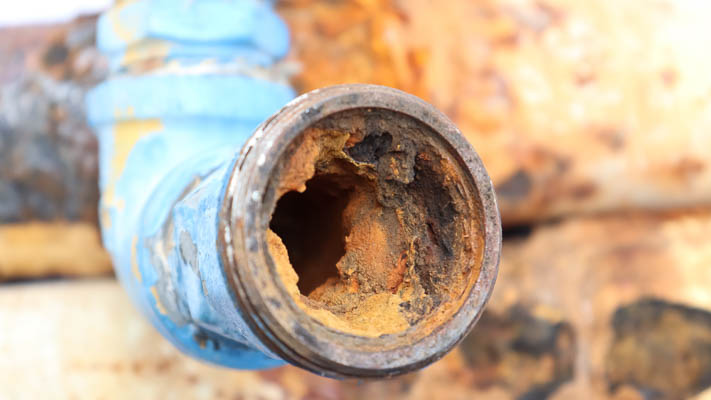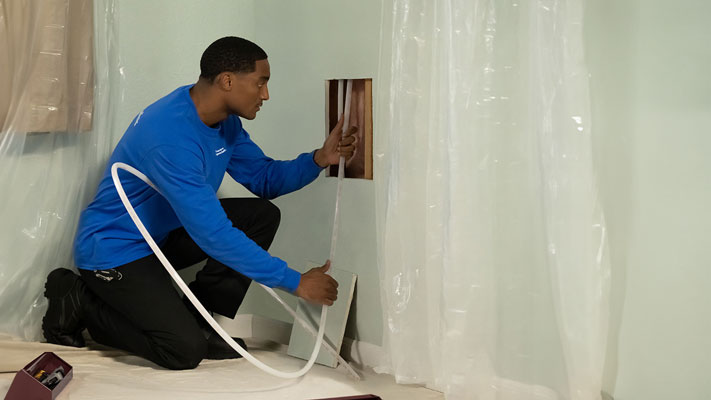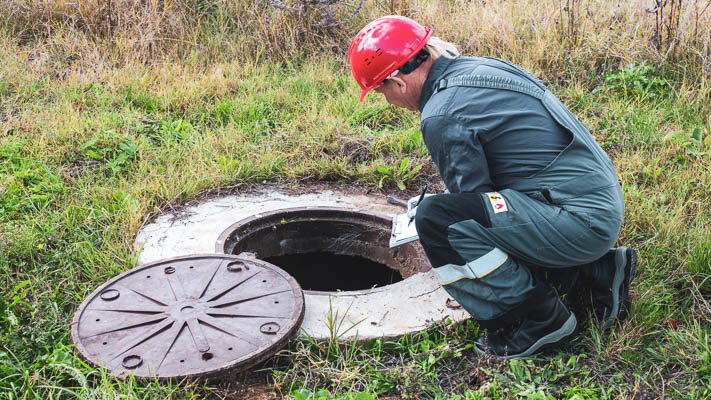What Is Municipal Water Pressure?
Municipal water pressure refers to the force that pushes water through the network of public supply pipes and into your home.
It's typically regulated by your local water authority and is designed to deliver water at a consistent pressure—usually between 40 and 80 PSI (pounds per square inch). To maintain that consistency, municipalities rely on:
- Gravity-fed systems using elevated storage tanks
- Booster pumps for pressurizing supply across long distances
- Pressure-regulating valves throughout the distribution system
Water pressure at your home can vary slightly based on elevation and distance from these key infrastructure points. That said, your home should still receive enough pressure to run multiple fixtures at once without major drops—unless something goes wrong.
Can the Municipal Water Supply Cause Low Water Pressure?
There are several instances in which your municipal water supplier might be the source of low pressure in your home. These issues can be temporary or symptoms of broader infrastructure problems.
Some common municipal causes of low pressure include:
- System Maintenance or Repairs: Water main work, flushing, or emergency repairs can result in temporary pressure drops in nearby homes.
- High-Demand Periods: Hot summer days or early morning hours may strain the local system, especially in densely populated areas.
- Pressure Regulator Adjustments: Sometimes, utilities lower pressure in specific areas to prevent system strain or pipe damage.
- Aging Infrastructure: In some areas, outdated municipal water mains may simply no longer be able to provide adequate pressure.
If multiple homes in your neighborhood are experiencing similar issues, it's likely the problem originates from the city's side of the system.
How to Check If Low Water Pressure Is Coming from the City
Before calling a plumber or considering a costly repair, it's important to rule out a municipal cause. Here's how to investigate:
- Ask Your Neighbors: If your neighbors are also experiencing low water pressure—especially around the same time of day—the issue likely originates with the municipal supply.
- Check for Utility Alerts: Visit your local water utility's website or call their support line. Many post outage and maintenance updates in real time.
- Test Your Pressure with a Gauge: Attach a water pressure gauge to an outdoor hose bib. If your pressure reads below 40 PSI consistently and you've ruled out in-home issues, it may be a supply problem. You can purchase a standard water pressure gauge from any local hardware store.
- Inspect the Main Shut-Off Valve: Ensure the main water shut-off valve to your house is fully open. A partially closed valve can mimic low municipal pressure.
Once you've determined whether the issue is localized or widespread, you'll be better equipped to decide your next step.
We have an article that details the many symptoms of low water pressure and their solutions.
Is My Low Water Pressure Caused by My Fresh Water Lines?
If your home is experiencing low water pressure, it's important to determine whether the issue lies within your freshwater plumbing system.
One of the clearest indicators is whether the problem is isolated to your home or affecting your entire neighborhood. If neighbors are also noticing a drop in pressure, it's likely related to the municipal supply. But if the issue seems unique to your property, the source may be your freshwater lines.

Low pressure that builds gradually or affects specific fixtures—such as just your shower or kitchen tap—is a strong sign of a systemic problem inside your home. Over time, old galvanized steel pipes can corrode, minerals from hard water can accumulate inside copper lines, and pressure regulators can fail. Each of these issues restricts the smooth flow of water through your plumbing and won't resolve without professional repair or replacement.
To confirm whether your freshwater lines are the problem, it helps to observe which fixtures are affected, compare pressure with nearby properties, and perform pressure testing if needed.
If you suspect the issue lies within your home's system, it's best to schedule a free consultation with our team to assess whether a repipe could restore your water pressure—and your peace of mind.
Get your free estimate today
With over 75,000 repipes completed, we've perfected our One-Stop Repipe™ for your home.
What to Do If Low Water Pressure Is Caused by Your Pipes
If your low water pressure is caused by internal issues, the right fix depends on the underlying cause. Here's what to look for:
- Check for Closed Valves: Make sure all valves (especially near the water heater and main supply) are fully open.
- Clean Aerators and Filters: Mineral buildup at the outlet can block flow. Unscrew and clean faucet and showerhead screens.
- Replace Old Pressure Regulators: If your PRV (pressure-reducing valve) is over 10 years old, it may need replacement.
- Flush the System: After local municipal work, silt may clog your pipes. Flushing the plumbing system can help clear debris.
Repiping Outdated Materials
In homes with old galvanized plumbing, scale-filled copper pipes, or undersized water lines, a full home repipe is often the only long-term solution.

There's no reliable way to clean the interior of corroded or scaled pipes, and patching sections typically leads to additional leaks elsewhere in the system. New plumbing materials—such as PEX (cross-linked polyethylene)—offer significantly more resistance to corrosion and mineral buildup than older materials.
At Repipe Specialists, we use high-quality Uponor PEX-A tubing, which provides long-term durability, flexibility, and fewer joints than traditional materials—making it ideal for restoring water pressure efficiently and reliably.
Get a Free Quote for Fixing Your Low Water Pressure
Here at Repipe Specialists, we've fully replaced the plumbing in over 75,000 homes since 1991. We frequently receive positive feedback from customers who are thrilled with their fast-flowing, high-pressure water after a repipe. We often exceed expectations in the following areas:
- Speed: Our repipe crews typically complete a repipe in a day, returning on another day for wall patching.
- Convenience: Through our One-Stop Repipe™ Process, we handle everything from permits, to wall patching, to inspections.
- Cleanliness: Our crews are trained to protect your home while working (we cover all surfaces with protective sheeting), and to clean up fully at the end of each day.
- Peace of Mind: Repipe Specialists is a fully licensed plumber in every state we operate in, and we back all of our repipes with a lifetime warranty.
- Financing programs: To help take the sting out of unplanned repipe expenses, we offer several financing programs.
- Price: As a specialist that performs hundreds of repipes a week, we can deliver high quality repipes at a lower cost vs generalist plumbers. We have an article that covers repipe cost factors in detail. Our quotes typically range from $4,500 to $15,000 depending on the size and complexity of your project.
Schedule a free in-home consult, and one of our local repipe consultants will explain all your repipe options and provide you with a written, fixed-price quote. Replace your outdated pipes and leave low water pressure in the past.

